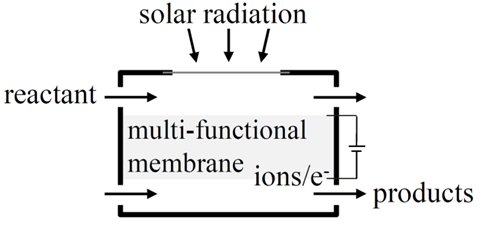Research overview
LRESE investigates the efficient and sustainable conversion of renewable energies (solar, wind, biomass, hydro and geothermal) into storable fuels, materials and commodities. A special focus lays on novel, solar-driven energy conversion and storage processes based on thermal, thermochemical and electrochemical processes. In addition, CO2 mitigation and capture, decarbonization and upgrading of fossil fuels and carbonaceous waste material, and processing of energy-intense materials are investigated.
Fundamental for these investigations are thermal sciences, fluid dynamics, electro-magnetism, and thermo/electro/photochemistry in complex multi-phase/multi-component media on multiple scales.
LRESE proposes novel and sustainable energy conversion and storage processes, studies their efficiency and potential, and experimentally demonstrates them. Further, we design and optimize materials, devices, and reactors used for these processes by developing multi-physics numerical models on mutliple scales. We investigate how devices and reactors can be scaled to be economically competitive and industrially feasible.
Solar-driven thermal, thermochemical and electrochemical processes
Efficient conversion and storage of solar energy is investigated. Solar-driven thermochemical processes of interest are multi-step redox cycles for water or CO2 splitting or gasification of carbonaceous waste material. Solar-driven electrochemical processes of interest are the electrolysis of water, CO2 and other commodities.
Reactor engineering

Various high and low-temperature reactors are studied to understand their limitations in efficient conversion and storage of renewable energies. Technologies of interest – beside the reactors for solar-driven processes – are flow batteries, fuel cells and electrolysers.
Morphological and transport characterization of complex multi-phase, multi-component media

Transport phenomena in various multi-phase media are investigated to understand the structure-property relation. A focus lies on radiative transport in heterogeneous, micro and nanostructured media. Tomography-based methods are used in direct discrete-scale numerical simulations.
LRESE software and models
Holistic design guidelines for photo-electrochemical devices: online version – Solar PhotoElectro-Chemical Device Optimization (SPECDO)
Structured device performance comparison for photo-electrochemical devices: online version – Solar PhotoElectroChemical Device Comparison (SPECDC)
Rapid material viability assessment for photoelectrode materials: online version – Performance Optimization of Photoelectrodes (POPe)
Database of photoelectrochemical solar hydrogen generation devices: online version – Solar Fuels DataBase (SolarFuelsDB)
Tools are available here.
Ongoing projects
(Photo)-electrochemistry and devices:
Strategic Computation and Optimization of Unified Templates for Solar Fuels (SCOUTS) – SNSF, Starting Grant project
Local production of an affordable solar fuel for clean cooking in Central Africa – Tech4Dev
Solar fuel devices database: Quantifying progress, unifying reporting, and enabling benchmarking – EPFL Open Science
Concentrated photoelectrochemical fuel generation: scale-up, on-sun testing, and flexibilization (On-SunCPEC) – BFE
Photoelectrodes and photoelectrochemical reactors for sustainable catalysis (NCCR catalysis) – SNF
Sustainable Chemicals with Sunlight and CO2 (FlowPhotoChem) – EU Horizont 2020
Solar Energy for Carbon-Free Liquid Fuel (Sun-to-X) – EU Horizont 2020
Selective Electrochemical Reduction of CO2 to High Value Chemicals (SelectCO2) – EU Horizont 2020
ITN on Solar Chemicals for a Sustainable Europe by Hybrid Molecule/Semiconductor Devices (Solar2Chem) – EU Horizon 2020 research and innovation programme under the Marie-Skłodowska-Curie
Disruptive Photonic Devices for Highly Efficient, Sunlight-Fueled Chemical Processes (Spotlight) – EU Horizont 2020
Overcoming fluid transport limitations in gas fed CO2 reduction devices with bipolar membranes – SNFS, project
High Performance Sodium Nickel Chloride Cell (HiPerSoNick) – BFE
Thermal / thermochemical devices:
Solar Textiles – H&M Foundation
At the interface to space applications:
Versatile energy, H2O, H2 and O2 production and storage system based on a reversible photo-electrochemical device – ESA
Past projects
(Photo)-electrochemistry and devices:
Solar Hydrogen Integrated Nano Electrolysis (SHINE) – SNSF, Nano-Tera project
Guided performance improvements of morphologically-complex multi-component photoelectrodes for scalable solar water splitting – SNSF, project
Coupled multi-phase transport in porous layers for fuel cells utilizing evaporative cooling – SNSF, project
Multi-Scale Analysis and Optimization of Photoelectrochemical Solar Fuel Generators – Hans-Eggenberger Foundation
Solar Integrated Pressurized High Temperature Electrolysis (SOPHIA) – EU, FCH JU project
At the interface to space applications:
Ceramic foams for high temperature applications in space and energy storage and conversion – CTI project
Lightweight ceramic foam composites and novel environmental testing for satellite applications – SERI/SSO project
Hybrid approach to ablation-radiation coupling – SNSF project
High-temperature heat storage:
Thermal Energy Storage Devices and Material Systems for Advanced Adiabatic Compressed Air Energy Storage – SNF, NFP70 project
Phase Change Material Systems for High Temperature Heat Storage – CTI, SCCER project